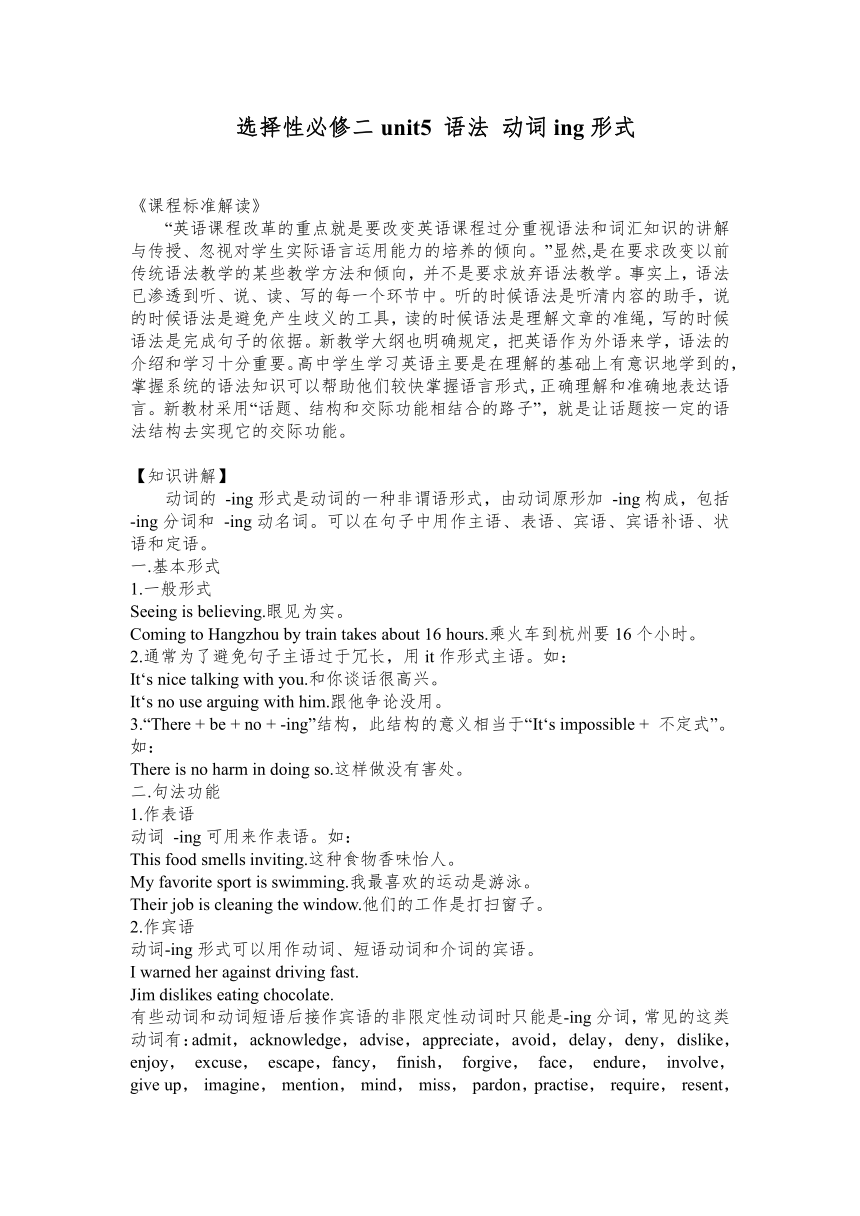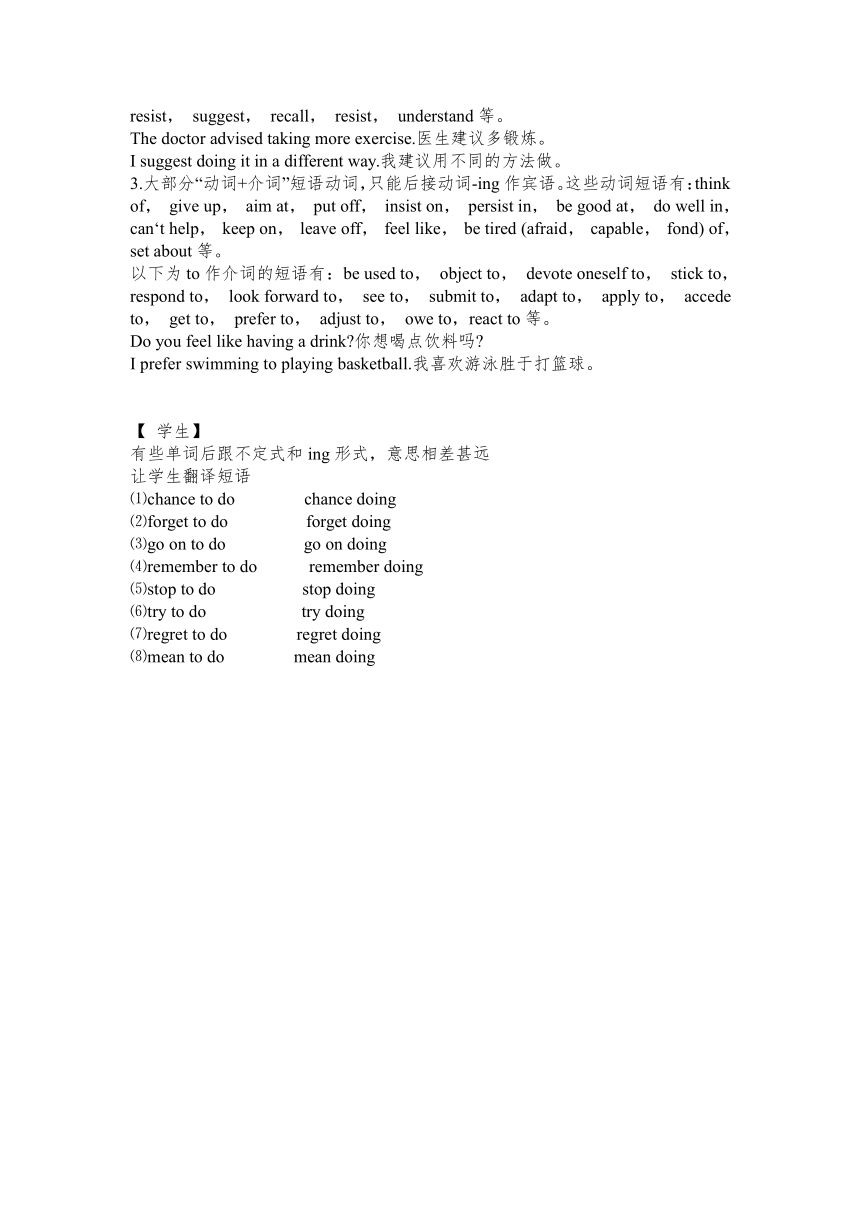人教版(2019)选择性必修第二册Unit 5 First Aid Discover Useful Structures 导学案(无答案)
文档属性
| 名称 | 人教版(2019)选择性必修第二册Unit 5 First Aid Discover Useful Structures 导学案(无答案) |  | |
| 格式 | docx | ||
| 文件大小 | 19.1KB | ||
| 资源类型 | 教案 | ||
| 版本资源 | 人教版(2019) | ||
| 科目 | 英语 | ||
| 更新时间 | 2024-05-17 12:54:09 | ||
图片预览


文档简介
选择性必修二unit5 语法 动词ing形式
《课程标准解读》
“英语课程改革的重点就是要改变英语课程过分重视语法和词汇知识的讲解与传授、忽视对学生实际语言运用能力的培养的倾向。”显然,是在要求改变以前传统语法教学的某些教学方法和倾向,并不是要求放弃语法教学。事实上,语法已渗透到听、说、读、写的每一个环节中。听的时候语法是听清内容的助手,说的时候语法是避免产生歧义的工具,读的时候语法是理解文章的准绳,写的时候语法是完成句子的依据。新教学大纲也明确规定,把英语作为外语来学,语法的介绍和学习十分重要。高中学生学习英语主要是在理解的基础上有意识地学到的,掌握系统的语法知识可以帮助他们较快掌握语言形式,正确理解和准确地表达语言。新教材采用“话题、结构和交际功能相结合的路子”,就是让话题按一定的语法结构去实现它的交际功能。
【知识讲解】
动词的 -ing形式是动词的一种非谓语形式,由动词原形加 -ing构成,包括 -ing分词和 -ing动名词。可以在句子中用作主语、表语、宾语、宾语补语、状语和定语。
一.基本形式
1.一般形式
Seeing is believing.眼见为实。
Coming to Hangzhou by train takes about 16 hours.乘火车到杭州要16个小时。
2.通常为了避免句子主语过于冗长,用it作形式主语。如:
It‘s nice talking with you.和你谈话很高兴。
It‘s no use arguing with him.跟他争论没用。
3.“There + be + no + -ing”结构,此结构的意义相当于“It‘s impossible + 不定式”。如:
There is no harm in doing so.这样做没有害处。
二.句法功能
1.作表语
动词 -ing可用来作表语。如:
This food smells inviting.这种食物香味怡人。
My favorite sport is swimming.我最喜欢的运动是游泳。
Their job is cleaning the window.他们的工作是打扫窗子。
2.作宾语
动词-ing形式可以用作动词、短语动词和介词的宾语。
I warned her against driving fast.
Jim dislikes eating chocolate.
有些动词和动词短语后接作宾语的非限定性动词时只能是-ing分词,常见的这类动词有:admit, acknowledge, advise, appreciate, avoid, delay, deny, dislike, enjoy, excuse, escape,fancy, finish, forgive, face, endure, involve, give up, imagine, mention, mind, miss, pardon,practise, require, resent, resist, suggest, recall, resist, understand等。
The doctor advised taking more exercise.医生建议多锻炼。
I suggest doing it in a different way.我建议用不同的方法做。
3.大部分“动词+介词”短语动词,只能后接动词-ing作宾语。这些动词短语有:think of, give up, aim at, put off, insist on, persist in, be good at, do well in, can‘t help, keep on, leave off, feel like, be tired (afraid, capable, fond) of, set about等。
以下为to作介词的短语有:be used to, object to, devote oneself to, stick to, respond to, look forward to, see to, submit to, adapt to, apply to, accede to, get to, prefer to, adjust to, owe to,react to等。
Do you feel like having a drink 你想喝点饮料吗
I prefer swimming to playing basketball.我喜欢游泳胜于打篮球。
【 学生】
有些单词后跟不定式和ing形式,意思相差甚远
让学生翻译短语
⑴chance to do chance doing
⑵forget to do forget doing
⑶go on to do go on doing
⑷remember to do remember doing
⑸stop to do stop doing
⑹try to do try doing
⑺regret to do regret doing
⑻mean to do mean doing
选择性必修二unit5 语法 动词ing形式
《课程标准解读》
“英语课程改革的重点就是要改变英语课程过分重视语法和词汇知识的讲解与传授、忽视对学生实际语言运用能力的培养的倾向。”显然,是在要求改变以前传统语法教学的某些教学方法和倾向,并不是要求放弃语法教学。事实上,语法已渗透到听、说、读、写的每一个环节中。听的时候语法是听清内容的助手,说的时候语法是避免产生歧义的工具,读的时候语法是理解文章的准绳,写的时候语法是完成句子的依据。新教学大纲也明确规定,把英语作为外语来学,语法的介绍和学习十分重要。高中学生学习英语主要是在理解的基础上有意识地学到的,掌握系统的语法知识可以帮助他们较快掌握语言形式,正确理解和准确地表达语言。新教材采用“话题、结构和交际功能相结合的路子”,就是让话题按一定的语法结构去实现它的交际功能。
【知识讲解】
句法功能
一.作宾语补语
I found the parade quite interesting to watch.
这种用法通常用在下列几类动词中,后接宾语然后加上-ing分词,构成复合宾语结构,-ing分词充当宾补成分。
1.表示感觉和心理状态的动词,如:see, hear, feel, find, smell, watch, find, listen to, look at, notice, observe等。如:
There we found him watching TV.我们发现他在那儿看电视。
I heard someone knocking at the door.我听见有人在敲门。
2.在有些动词(如:regard, describe, accept, think of, quote等)之后,可由as引出-ing分
词词组作宾补。如:
They regarded the contract as being invalid.他们认为合同无效。
They described the child as being very clever.他们描述这孩子非常聪明。
3.使役动词,如:set, keep, have, get, leave, catch等。如:
Can you get my watch going again 你能使我的表再走起来吗
This sets me thinking.这使我思考。
二.作状语
-ing分词作状语表示在进行一动作的同时所进行的另一动作,它对谓语动词起修饰和 陪衬的作用。分词作状语可以表示时间、原因、条件、让步、结果、方式或伴随情况。
Having cleaned the rooms we began to weed the garden.(时间)
打扫完房间,我们开始在花园里除草。
Coming into the room, she saw everybody already at their work.(时间)
进屋以后,她看到人人都在工作。
Being ill, he couldn‘t go to school.(原因)
因为生病,他不能去上学。
Having no interest in the topic, he didn‘t go to the lecture.(原因)
由于对这个话题没有兴趣,他没去参加讲座。
Working diligently, you will certainly succeed.(条件)
只要刻苦学习,你会成功的。
Using atomic energy, we can build spaceships.(条件)
利用原子能,我们能够建造太空船。
Granting the achievements to be great, there is still something to be desired.(让步)
(尽管)成绩是巨大的,(但)仍有一些要求改进的东西。
My car was caught in a traffic jam, thus causing the delay.(结果)
我的车被交通拥挤堵住,所以延误了。
Traveling by train, we visited a number of cities.(方式)
我们坐火车访问了好多城市。
Mary sat by the window of the classroom, reading a book.(伴随)
玛丽坐在教室的窗户旁,正在读一本书。
三.作定语
分词作定语时和形容词的功能是相似的。-ing分词可以单独作定语,如:
a smiling face 笑脸
a leading figure 领导人物
-ing分词还能构成合成词作定语,如:
easy-going man 好说话的人
当分词短语做后置定语时,可以转换成定语从句。
She went on board the train leaving for Shanghai.
= She went on board the train, which was leaving for Shanghai.
她乘坐了去上海的火车。
【 学生】
1. ______(hand in) his exercise book, he was scolded(批评) by the teacher.
2. It was______(surprise) to see all the students______(seat/sit)silently in the classroom.
3. China became the 143rd member of the WTO on Decomber 11,2001,thus______(realize) its 15-year wish to join the global trade body.
4. While watching television,______(门铃响了) .
5. “You can’t catch me!” John shouted,______(run) away.
6. The picture______(hang) on the wall is painted by my nephew.
7.______(suffer) from heart trouble for years, Professor White has to take some medicine with him whenever he goes.
《课程标准解读》
“英语课程改革的重点就是要改变英语课程过分重视语法和词汇知识的讲解与传授、忽视对学生实际语言运用能力的培养的倾向。”显然,是在要求改变以前传统语法教学的某些教学方法和倾向,并不是要求放弃语法教学。事实上,语法已渗透到听、说、读、写的每一个环节中。听的时候语法是听清内容的助手,说的时候语法是避免产生歧义的工具,读的时候语法是理解文章的准绳,写的时候语法是完成句子的依据。新教学大纲也明确规定,把英语作为外语来学,语法的介绍和学习十分重要。高中学生学习英语主要是在理解的基础上有意识地学到的,掌握系统的语法知识可以帮助他们较快掌握语言形式,正确理解和准确地表达语言。新教材采用“话题、结构和交际功能相结合的路子”,就是让话题按一定的语法结构去实现它的交际功能。
【知识讲解】
动词的 -ing形式是动词的一种非谓语形式,由动词原形加 -ing构成,包括 -ing分词和 -ing动名词。可以在句子中用作主语、表语、宾语、宾语补语、状语和定语。
一.基本形式
1.一般形式
Seeing is believing.眼见为实。
Coming to Hangzhou by train takes about 16 hours.乘火车到杭州要16个小时。
2.通常为了避免句子主语过于冗长,用it作形式主语。如:
It‘s nice talking with you.和你谈话很高兴。
It‘s no use arguing with him.跟他争论没用。
3.“There + be + no + -ing”结构,此结构的意义相当于“It‘s impossible + 不定式”。如:
There is no harm in doing so.这样做没有害处。
二.句法功能
1.作表语
动词 -ing可用来作表语。如:
This food smells inviting.这种食物香味怡人。
My favorite sport is swimming.我最喜欢的运动是游泳。
Their job is cleaning the window.他们的工作是打扫窗子。
2.作宾语
动词-ing形式可以用作动词、短语动词和介词的宾语。
I warned her against driving fast.
Jim dislikes eating chocolate.
有些动词和动词短语后接作宾语的非限定性动词时只能是-ing分词,常见的这类动词有:admit, acknowledge, advise, appreciate, avoid, delay, deny, dislike, enjoy, excuse, escape,fancy, finish, forgive, face, endure, involve, give up, imagine, mention, mind, miss, pardon,practise, require, resent, resist, suggest, recall, resist, understand等。
The doctor advised taking more exercise.医生建议多锻炼。
I suggest doing it in a different way.我建议用不同的方法做。
3.大部分“动词+介词”短语动词,只能后接动词-ing作宾语。这些动词短语有:think of, give up, aim at, put off, insist on, persist in, be good at, do well in, can‘t help, keep on, leave off, feel like, be tired (afraid, capable, fond) of, set about等。
以下为to作介词的短语有:be used to, object to, devote oneself to, stick to, respond to, look forward to, see to, submit to, adapt to, apply to, accede to, get to, prefer to, adjust to, owe to,react to等。
Do you feel like having a drink 你想喝点饮料吗
I prefer swimming to playing basketball.我喜欢游泳胜于打篮球。
【 学生】
有些单词后跟不定式和ing形式,意思相差甚远
让学生翻译短语
⑴chance to do chance doing
⑵forget to do forget doing
⑶go on to do go on doing
⑷remember to do remember doing
⑸stop to do stop doing
⑹try to do try doing
⑺regret to do regret doing
⑻mean to do mean doing
选择性必修二unit5 语法 动词ing形式
《课程标准解读》
“英语课程改革的重点就是要改变英语课程过分重视语法和词汇知识的讲解与传授、忽视对学生实际语言运用能力的培养的倾向。”显然,是在要求改变以前传统语法教学的某些教学方法和倾向,并不是要求放弃语法教学。事实上,语法已渗透到听、说、读、写的每一个环节中。听的时候语法是听清内容的助手,说的时候语法是避免产生歧义的工具,读的时候语法是理解文章的准绳,写的时候语法是完成句子的依据。新教学大纲也明确规定,把英语作为外语来学,语法的介绍和学习十分重要。高中学生学习英语主要是在理解的基础上有意识地学到的,掌握系统的语法知识可以帮助他们较快掌握语言形式,正确理解和准确地表达语言。新教材采用“话题、结构和交际功能相结合的路子”,就是让话题按一定的语法结构去实现它的交际功能。
【知识讲解】
句法功能
一.作宾语补语
I found the parade quite interesting to watch.
这种用法通常用在下列几类动词中,后接宾语然后加上-ing分词,构成复合宾语结构,-ing分词充当宾补成分。
1.表示感觉和心理状态的动词,如:see, hear, feel, find, smell, watch, find, listen to, look at, notice, observe等。如:
There we found him watching TV.我们发现他在那儿看电视。
I heard someone knocking at the door.我听见有人在敲门。
2.在有些动词(如:regard, describe, accept, think of, quote等)之后,可由as引出-ing分
词词组作宾补。如:
They regarded the contract as being invalid.他们认为合同无效。
They described the child as being very clever.他们描述这孩子非常聪明。
3.使役动词,如:set, keep, have, get, leave, catch等。如:
Can you get my watch going again 你能使我的表再走起来吗
This sets me thinking.这使我思考。
二.作状语
-ing分词作状语表示在进行一动作的同时所进行的另一动作,它对谓语动词起修饰和 陪衬的作用。分词作状语可以表示时间、原因、条件、让步、结果、方式或伴随情况。
Having cleaned the rooms we began to weed the garden.(时间)
打扫完房间,我们开始在花园里除草。
Coming into the room, she saw everybody already at their work.(时间)
进屋以后,她看到人人都在工作。
Being ill, he couldn‘t go to school.(原因)
因为生病,他不能去上学。
Having no interest in the topic, he didn‘t go to the lecture.(原因)
由于对这个话题没有兴趣,他没去参加讲座。
Working diligently, you will certainly succeed.(条件)
只要刻苦学习,你会成功的。
Using atomic energy, we can build spaceships.(条件)
利用原子能,我们能够建造太空船。
Granting the achievements to be great, there is still something to be desired.(让步)
(尽管)成绩是巨大的,(但)仍有一些要求改进的东西。
My car was caught in a traffic jam, thus causing the delay.(结果)
我的车被交通拥挤堵住,所以延误了。
Traveling by train, we visited a number of cities.(方式)
我们坐火车访问了好多城市。
Mary sat by the window of the classroom, reading a book.(伴随)
玛丽坐在教室的窗户旁,正在读一本书。
三.作定语
分词作定语时和形容词的功能是相似的。-ing分词可以单独作定语,如:
a smiling face 笑脸
a leading figure 领导人物
-ing分词还能构成合成词作定语,如:
easy-going man 好说话的人
当分词短语做后置定语时,可以转换成定语从句。
She went on board the train leaving for Shanghai.
= She went on board the train, which was leaving for Shanghai.
她乘坐了去上海的火车。
【 学生】
1. ______(hand in) his exercise book, he was scolded(批评) by the teacher.
2. It was______(surprise) to see all the students______(seat/sit)silently in the classroom.
3. China became the 143rd member of the WTO on Decomber 11,2001,thus______(realize) its 15-year wish to join the global trade body.
4. While watching television,______(门铃响了) .
5. “You can’t catch me!” John shouted,______(run) away.
6. The picture______(hang) on the wall is painted by my nephew.
7.______(suffer) from heart trouble for years, Professor White has to take some medicine with him whenever he goes.
